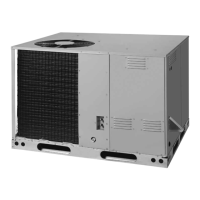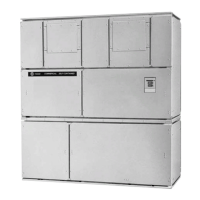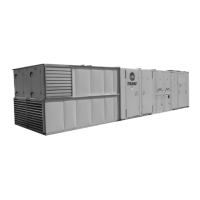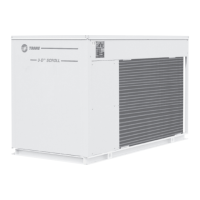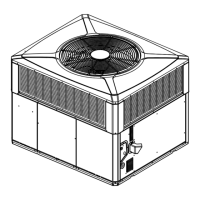Do you have a question about the Trane 400 and is the answer not in the manual?
Introduction to manual, emphasis on user and technician roles.
Highlights safety warnings (WARNING/CAUTION) and potential hazards.
Lists crucial safety measures for maintenance and service visits.
Instructions for inspecting the unit upon arrival and reporting damages.
Details warranty terms, void conditions, and user obligations.
Explains unit nameplate information like model, power rating, and amperage.
Covers foundation requirements and general installation guidelines.
Details the standard supply and placement of anti-vibration pads.
Emphasizes maintaining recommended clearance for maintenance and airflow.
Provides instructions and cautions regarding unit handling and lifting.
Discusses calculation and fixing of refrigerant lines for oil return and pressure drop.
Criteria for calculating liquid line capacity, avoiding evaporation.
Criteria for calculating discharge line diameter for oil drive.
Importance of insulating lines to prevent vibration transmission.
Precautions and procedures for pressure testing and leak detection.
Procedure for introducing refrigerant and checking for leaks.
Details adjusting oil quantity based on piping and specialists' role.
Care and compliance for installing electrical wiring and cables.
Details fitting temperature sensors for measuring airflow temperature.
Explains the hot gas bypass option and its components.
Describes how the hot gas bypass solenoid valve operates.
Outlines rules for hot gas bypass operation if installed and enabled.
Explains air temperature control and external capacity control options.
Details standard air temp control using evaporator leaving air sensor.
Describes optional external capacity control configuration.
Checklist for installers before calling for service.
Step-by-step instructions for correctly starting up the unit.
Ensures all preparation steps are followed and checks unit condition.
Checks oil level, capillary tubes, controls, and refrigerant circuit tightness.
Verifies electrical terminals, overload relays for motors and fans.
Checks control wiring, pressostats, and control module setup.
Checks safety valve, fan rotation, and motor isolation.
Details checks for voltage, currents, temperatures, pressures, and superheat.
Final checks on unit cleanliness, valve positions, and panel doors.
Warranty requirements, insulation resistance, phase imbalance, voltage.
Mentions control via the CH530 control module.
Instructions for starting up the unit using the control module.
Procedures for shutting down the unit for short periods.
Steps for shutting down the unit for longer periods.
Checks and procedures for starting up the unit after seasonal shutdown.
Specific checks required after the first 500 hours of operation.
Tasks for monthly preventive maintenance checks.
Tasks for annual preventive maintenance checks.
Refers to Trane documentation for oil, cleaning procedures, and maintenance contracts.
Safety warning about switching off power before intervention.
Checks for damage and equipment conformity upon delivery.
Verifies unit placement, leveling, clearances, and pad position.
Checks for filter dryer, sight glass, oil traps, and refrigerant presence.
Checks motor rotation, power switch, and electrical connections.
Checks cooling charge and coordination with other trades.
Lists common causes and actions for compressor not starting.
Lists causes and actions for compressor stopping due to high pressure or thermal relays.
Lists causes and actions for compressor stopping shortly after starting.
Addresses issues where the compressor runs continuously.
Discusses causes and solutions for oil loss in the compressor.
Lists causes for compressor noise and knocks.
Identifies causes and solutions for reduced cooling capacity.
Addresses high discharge pressure due to hot condenser or airflow issues.
Explains causes for high suction pressure and continuous compressor operation.
Lists causes for low suction pressure, including filter drier and expansion valve issues.
Clarifies the scope of the troubleshooting guide for operators.
Illustrates the psychrometric chart points for understanding performance data.
Provides pressure-temperature data for R407C refrigerant.
Provides pressure-temperature data for R134a refrigerant.
| Brand | Trane |
|---|---|
| Model | 400 |
| Category | Heating System |
| Language | English |


